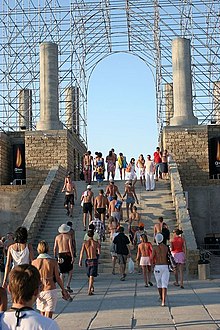KaZantip
KaZantip ( Ukrainian каЗантип, Ка Z антип , Crimean Tatar QaZantıp ) was an annual festival for electronic dance music . During the festival, over 300 disc jockeys played on numerous dance floors around the clock at each event . It was visited by 70,000 to 100,000 young people annually. Initially, the majority of the visitors came from the countries of the CIS and the eastern member states of the EU , but in recent years it has increasingly attracted visitors from Western Europe and North America.
history
The inventor of the festival is Nikita Olegowitsch Marschunok. In 1992 he organized a surfing competition in the Crimea , which ended with a festival. In the following years, the festival was expanded and decoupled from the actual surfing competition. From 1997 to 1999 it took place a few kilometers south of the Cape Kazan type , which gave the festival its name, with around 10,000 visitors in the ruins of the Crimean nuclear power plant , which was never connected to the grid. In 2000 the event was held in Wessele . From 2001 to 2013, the six-hectare festival site was on the beach in the village of Popovka in the western part of Crimea, about 28 km west of Evpatoria .
Due to the Russian annexation of Crimea, the 2014 festival could not take place in Popovka. This made an alternative location necessary, which was found in Anaklia , Georgia . In addition, the event had to be postponed to a later date than originally planned. In Georgia, the festival caused controversy as the Georgian Orthodox Church protested the event; This resulted in dismissals in the Georgian Tourism Authority. In 2015, the festival was originally scheduled to take place in Sihanoukville , Cambodia in February , but the event was temporarily banned by local authorities.
Republic of KaZantip
The special thing about the festival was its organization as a fictional state: Marschunok founded the imaginary "Republic of KaZantip", appointed himself "President", a few friends as "Ministers for Sound, Good Mood and Architecture" and wrote a "Constitution". Visitors to the festival paid for a “visa”, which entitles them to multiple entry and made them “citizens of the republic”.
Many later elements of the festival were also created through contributions and discussions by festival participants. The special atmosphere of the event was mostly thanks to long-standing visitors and their voluntary work.
The yellow suitcase was one of the main symbols of the "Republic of KaZantip". In the course of the first few years, certain rules for its design and appearance emerged, which were listed on the official website. Such suitcases, which complied with the rules and whose registration was accepted, granted their owners unlimited and free entry to the festival site. However, the application for registration had to be submitted every year within a period specified on the official website.
literature
- Dagmar Sonderegger among others: The Crimea. Out and about on the sunny island in the Black Sea. 4th act. u. revised Edition, Trescher, Berlin 2007, ISBN 978-3-89794-115-1 , p. 306.
- Christine Neder: 40 festivals in 40 weeks. From someone who set out to learn to celebrate. Schwarzkopf & Schwarzkopf, Berlin 2012, ISBN 978-3-86265-195-5 , chapter 29.
Web links
- Official website (English, Russian)
- TV report on RTL 2 Spezial (September 2012)
- TV report on Kabel 1 Abenteuer Leben and Pro 7 Taff (September 2012)


